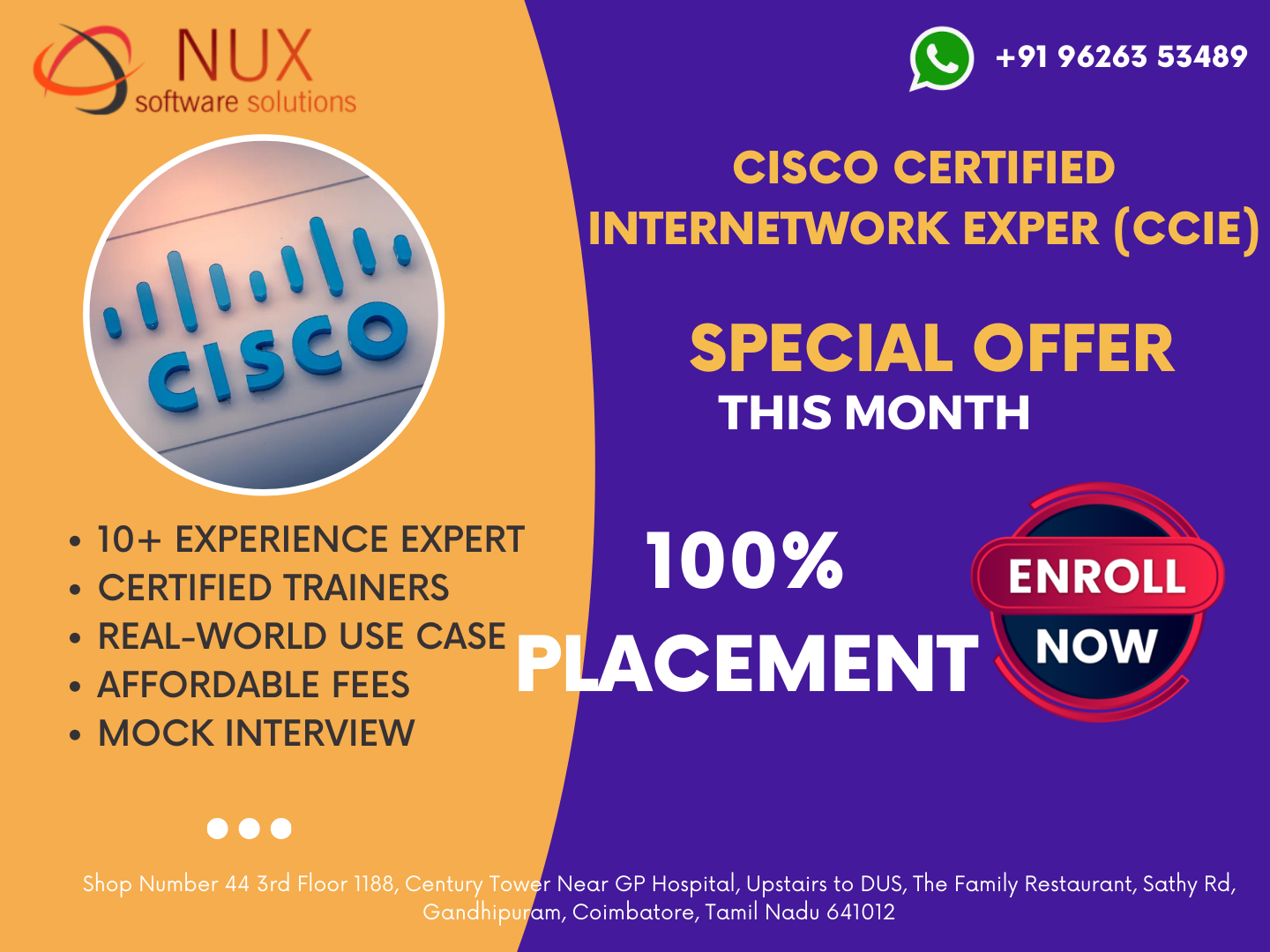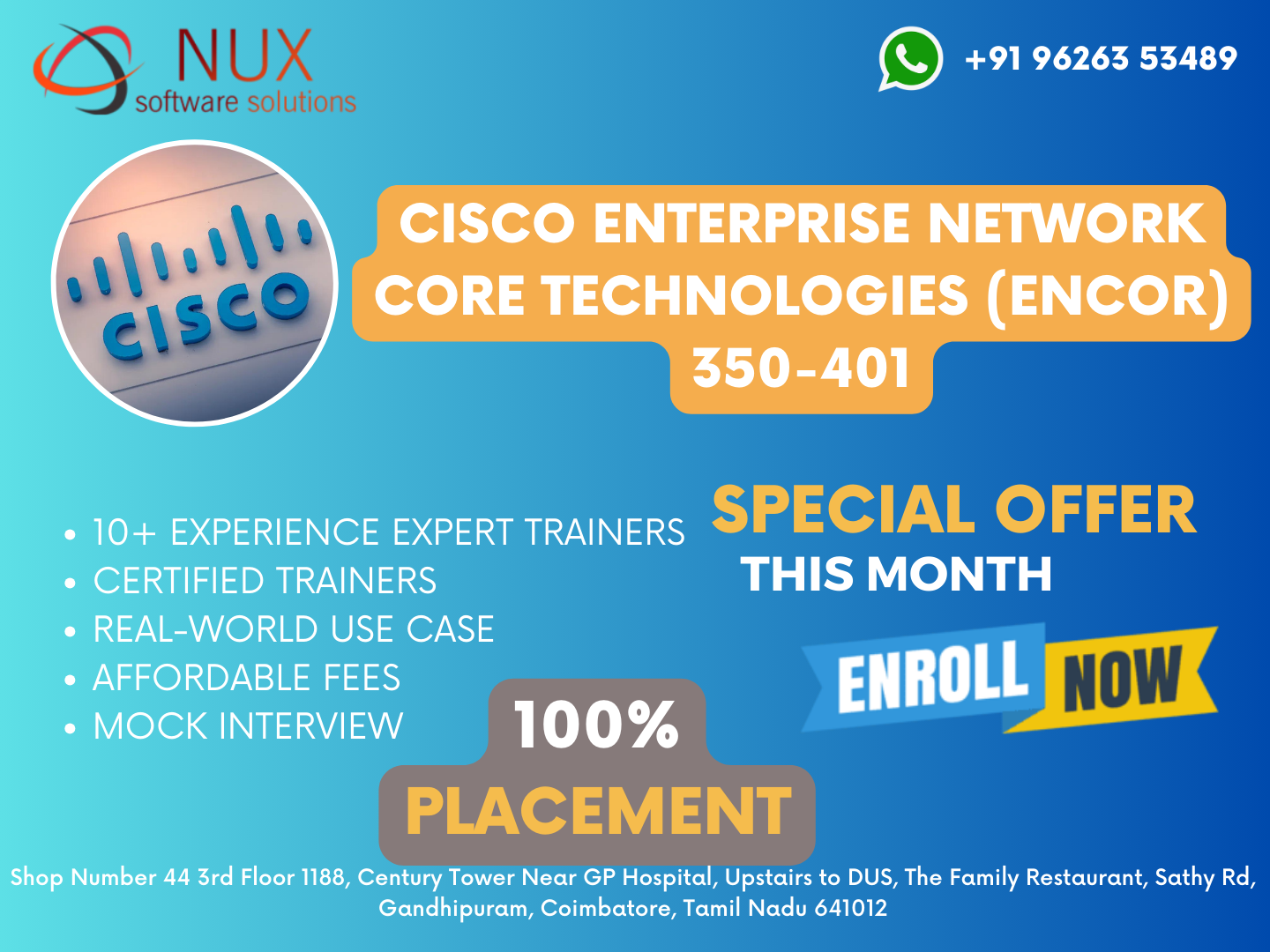Cisco Certified Internet work Expert (CCIE)


Cisco Certified Internetwork Expert (CCIE) Training Institute In Coimbatore: Best Cisco Certified Internetwork Expert (CCIE) training courses classes deliver by Nux software solutions in coimbatore. Nux software solutions in coimbatore has excellent and advanced training programs that will give you better performance & hands on experience.
Our industry’s expert trainers offer a wide range of skills and experience in their graded areas. The Training center environment is too good for professional, individual, corporate, live project training and industrial training. Labs infrastructure is advanced, well managed and you can access LAB 24X7 from anywhere. Training center has international expert trainers and they have excellent knowledge, real time industry experience.
Our Training programs combine with several innovative learning methods and delivery models. We understand your requirement and it will give you 100 percent growth for your career and provide the cost effective training programs and also work with flexibility for the trainees.
Moreover, we have designed a lab having the well-equipped infrastructure and 24/7 accessible facility that is ideal even for professionals, corporate, individuals, live project training, industrial training as well.
We have placed above 500 registered companies and 10000+ students and professionals, all are working in the reputed positions.
Course Syllabus
Module 1
Describe WLAN organizations and regulations
Chapter 2
Describe IEEE 802.11 standards and protocols
Chapter 3
Plan & design wireless solutions requirements,
a) Translate customer requirements into services and design recommendations,
b) Identify ambiguity and/or information gaps,
c) Evaluate interoperability of proposed technologies against deployed IP network infrastructure & technologies,
d) Select an appropriate deployment model,
e) Regulatory domains and country codes Chapter 4
RF planning, designing and validation
a) RF Design / Site survey
[i] Define the tasks/goals for a preliminary site survey, [ii] Conduct the site survey, [iii] Determine AP quantity, placement and antenna type
b) Architect indoor and outdoor RF deployments
[i] Coverage, [ii] Throughput, [iii]Voice, [iv]Location, [v] High Density / Very High Density
c) Construct an RF operational model that includes:
[i] Radio resource management (Auto-RF, manual, hybrid, Flexible Radio Assignment, TPC and DCA), [ii] Channel use (radar, non-WiFi interference, Dynamic Bandwidth Selection), [iii] Power level, overlap, [iv] RF profiles
d) Validate implemented RF deployment
Module 2 - Configure and Troubleshoot the Network Infrastructure
Configure and troubleshoot wired infrastructure to support WLANs, a) VLANs, b) VTP, c) STP, d) Etherchannel
Chapter 2
Plan network infrastructure capacity
Chapter 3
Configure and troubleshoot network connectivity for:, a) WLAN clients, b) WLCs (appliance, virtual, and Mobility Express), c) Lightweight APs, d) Autonomous APs
Chapter 4
Configure and troubleshoot PoE for APs
Chapter 5
Configure and troubleshoot QoS on the switching infrastructure
a) MQC, b) MLS QoS
Chapter 6
Configure and troubleshoot multicast on the switching infrastructure, a) PIM, b) Basic IGMP (including IGMP snooping), c) MLD
Chapter 7
Configure and troubleshoot IPv4 connectivity, a) Subnetting, b) Static and inter-VLAN routing
Chapter 8
Configure and troubleshoot basic IPv6 connectivity, a) Subnetting, b) Static and inter-VLAN routing
Chapter 9
Configure and troubleshoot wired security for APs, a) MAB, b) dot1X for APs
Chapter 10
Configure and troubleshoot the following to support wireless services,
a) DNS, b) DHCPv4 / DHCPv6, c) NTP, SNTP, d) SYSLOG, e) SNMP, f) CDP, LLDP, g) mDNS (including SDG)
Module 3 - Configure and Troubleshoot an Autonomous Deployment Model
Configure and troubleshoot different modes and roles, a) WGB, b) Point to point & Point to multi-point bridge
Chapter 2
Configure and troubleshoot SSID/MBSSID
Chapter 3
Configure and troubleshoot security, a) L2 security policies, b) Association filters, c) Local radius, d) dot1X profiles
Chapter 4
Configure and troubleshoot radio settings
Chapter 5
Configure and troubleshoot multicast
Chapter 6
Configure and troubleshoot QoS
Module 4 - Configure and Troubleshoot AireOS appliance, virtual, and Mobility Express controllers
Configure and troubleshoot secure management access and control plane, a) AAA, b) CPU ACLs, c) Management via wireless interface, d) Management via dynamic interface
Chapter 2
Configure and troubleshoot interfaces
Chapter 3
Configure and troubleshoot lightweight APs, a) dot1x, b) AP modes, c) AP authentication / AP authorization, d) Logging, e) Local AP CLI configuration, f) WLC based AP configuration
Chapter 4
Configure and troubleshoot high availability and redundancy, a) SSO, b)N+1, N+N
Chapter 5
Configure and troubleshoot wireless segmentation, a) RF profiles, b) AP groups, c) FlexConnect
Chapter 6
Configure and troubleshoot wireless security policies, a) WLANs, b) L2/L3 security, c) Rogue policies, d) Local EAP, e) Local profiling, f) ACLs, g) Certificates
Chapter 7
Configure and troubleshoot FlexConnect and Office Extend
Chapter 8
Configure and troubleshoot Mesh
Chapter 9
Implement RF management, a) Static RF management, b) Automatic RF management, c) CleanAir, d) Data rates, e) RX-SOP, f) Air Time Fairness (ATF), g) Flexible Radio Assignment (FRA)
Chapter 10
Configure and troubleshoot mobility, a) L2/L3 roaming, b) Multicast optimization, c) Mobility group scaling, d) Inter-release controller mobility, e) Mobility anchoring
Chapter 11
Configure and troubleshoot multicast
Chapter 12
Configure and troubleshoot client roaming optimization, a) CCKM, b) Optimized Roaming, c) Band Select, d) Load Balancing, e) 802.11r/k/v
Module 5 - Configure and Troubleshoot Wireless Security & Identity Management with ISE
a) Basic PKI for dot1x and WebAuth, b) External identity sources (AD)
Chapter 2
Configure and troubleshoot AAA policies, a) Client authentication and authorization, b) Management authentication and authorization, c) Client profiling and provisioning, d) RADIUS attributes, e) CoA
Chapter 3
Configure and troubleshoot wireless guest management, a) Local web authentication, b) Central web authentication, c) Basic sponsor policy
Module 6 - Configure and Troubleshoot Prime Infrastructure and MSE/CMX
Configure and troubleshoot management access, a) AAA, b) Virtual domain
Chapter 2
Perform basic operations, a) Create and deploy templates, b) Operate maps, c) Import infrastructure devices, d) High availability, e) Audits f) Client troubleshooting, g) Notification receivers, h) Reports, i) Monitoring policies
Chapter 3
Configure and troubleshoot Prime Infrastructure jobs
Chapter 4
Operate Security management, a) Configure rogue management, b) Manage alarms and events
Chapter 5
Implement and troubleshoot MSE/CMX,
a) Management access,
b) Network services
[i] Location, [ii] Analytics, [iii] Connect and Engage, [iv] CleanAir, [v] wIPS c) NMSP
Chapter 6
Integrate ISE with Prime Infrastructure and MSE/CMX
Module 7 - Configure and Troubleshoot WLAN media and application services
Configure and troubleshoot voice over wireless, a) QoS profiles, b) EDCA, c) WMM, d) BDRL, e) Admission control, f) MQC/MLS
Chapter 2
Configure and troubleshoot video and media, a) Media Stream, b) Admission control
Chapter 3
Configure and troubleshoot mDNS, a) mDNS proxy, b) Service discovery, c) Service filtering
Chapter 4
Configure and troubleshoot AVC and netflow
Chapter 5
Configure and troubleshoot FastLane and Adaptive Fast Transition (802.11r)
Module 8 - Evolving Technologies v1.1
Cloud a) Compare and contrast public, private, hybrid, and multicloud design considerations
[i] Infrastructure, platform, and software as a service (XaaS), [ii] Performance, scalability, and high availability, [iii] Security implications, compliance, and policy, [iv] Workload migration
b) Describe cloud infrastructure and operations
[i] Compute virtualization (containers and virtual machines), [ii] Connectivity (virtual switches, SD-WAN and SD-Access), [iii] Virtualization functions (NFVi, VNF, and L4/L6), [iv] Automation and orchestration tools (CloudCenter, Cisco DNA-center, and Kubernetes) Chapter 2
Network programmability (SDN)
a) Describe architectural and operational considerations for a programmable network [i] Data models and structures (YANG, JSON and XML), [i] Device programmability (gRPC, NETCONF and RESTCONF), [ii] Controller based network design (policy driven configuration and northbound/ southbound APIs), [iii] Configuration management tools (agent and agentless) and version control systems (Git and SVN)
Chapter 3
Internet of things (IoT)
a) Describe architectural framework and deployment considerations for IoT, [i] IoT technology stack (IoT Network Hierarchy, data acquisition and flow), [ii] IoT standards and protocols (characteristics within IT and OT environment), [iii] IoT security (network segmentation, device profiling, and secure remote)


